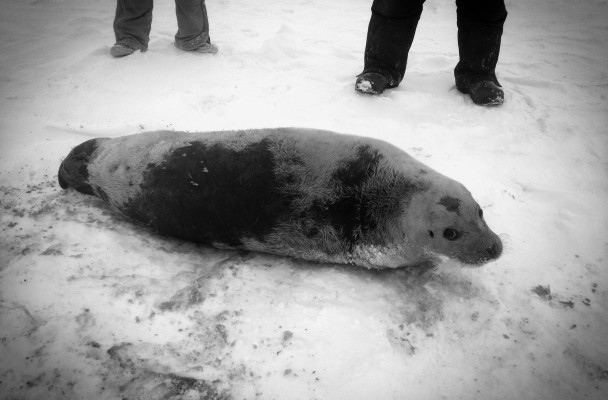
Last Friday evening a bearded seal made its way out of Nome’s iced-in port and up into the west side of town. The seal spent the night at Nome’s Public Safety Building and after observing its behavior, it was clear what to do next.
“It was feisty, it was fat, it wanted to be left alone,” said Brandon Ahmasuk. “So the decision was made to release it.”
Ahmasuk is the Subsistence Director for Kawerak as well as the Bering Strait Commissioner for the Ice Seal Commission, two roles that prepare him for strandings such as this one.
Besides looking a little patchy and out of place in the snow-covered parking lot, there didn’t seem to be anything usual about the seal. Ahmasuk explained that the recent arrival of sea ice might help explain the stranding.
“At the end of the port, about a week ago, the ice hadn’t come in yet so it was our belief that it was just hanging out right inside the port on the ice and then that ice, the sea ice, came in and blocked off its exit,” he said.
In the case of a marine mammal stranding in our region, there are three options: release the animal back into the wild, harvest it for subsistence, or send it down to the Alaska SeaLife Center in Seward, which handles marine mammal rehabilitation.
Although this particular seal wasn’t acting unusually, the region does have a history of seal sickness.
Gay Sheffield, who works for the University of Alaska Fairbanks Alaska Sea Grant, is Nome’s local stranding responder and was one of the first on the scene. She explained the unusual mortality event, or UME that struck the region a few years back.
“2011 was the year it was most pronounced,” Sheffield said. The seals seemed tired and wouldn’t move out of peoples’ way. She also explained that they had both internal and external problems, including sores.
“Since then we haven’t seen conditions like that,” Sheffield said, “but we do keep seeing seals that have lost their ability to grow their coat properly.”
Ahmasuk said it was that same condition that discouraged locals from harvesting the seal.
“We did ask around town other subsistence users if they wanted it,” Ahmasuk said, but everyone said no.
“Subsistence users, they’re pretty leery about harvesting something that they don’t even know what’s causing it. If they ingest it is that disease going transfer over to us?”
Sheffield said it’s been an uphill battle to figure out exactly what’s been preventing seals from growing a proper coat. She said there’s a long list of diseases they’ve eliminated, but still haven’t pinpointed one to explain it all.
Using a large fish tote donated by the Norton Sound Economic Development Corporation, the seal was transported back down to the beach. Along with needing extra hands to move the tote with the 200-pound seal, local hunters also helped determine the best place to release it.
“The seal was released off the west beach and sea ice conditions were not terribly stable, but the guys who released it, the marine mammal hunters, are extremely knowledgeable in ice conditions,” Sheffield said.
Sheffield went back to the beach the following day; she says there were at least four seals hauled out on the sea ice. She described it as a “good ending for our unexpected visitor.”
The statewide marine mammal stranding hotline is (877) 925-7773.
